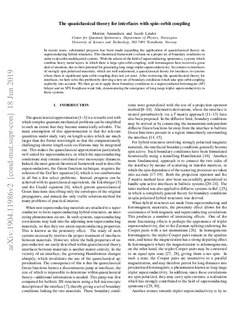| dc.contributor.author | Amundsen, Morten | |
| dc.contributor.author | Linder, Jacob | |
| dc.date.accessioned | 2020-01-13T09:39:22Z | |
| dc.date.available | 2020-01-13T09:39:22Z | |
| dc.date.created | 2019-08-06T12:01:03Z | |
| dc.date.issued | 2019 | |
| dc.identifier.issn | 2469-9950 | |
| dc.identifier.uri | http://hdl.handle.net/11250/2635872 | |
| dc.description.abstract | In recent years, substantial progress has been made regarding the application of quasiclassical theory on superconducting hybrid structures. This theoretical framework is reliant on a proper set of boundary conditions in order to describe multilayered systems. With the advent of the field of superconducting spintronics, systems that combine heavy metal layers, in which there is large spin-orbit coupling, with ferromagnets have received a great deal of attention, due to their potential for generating long-range triplet superconductivity. In contrast to interfaces of strongly spin-polarized materials, which are well understood, a quasiclassical theory for interfaces in systems in which there is significant spin-orbit coupling does not yet exist. After reviewing the quasiclassical theory for interfaces, we solve this problem here by deriving a set of boundary conditions that take spin-orbit coupling explicitly into account. We then go on to apply these boundary conditions to a superconductor-ferromagnet bilayer and a superconductor-ferromagnet-superconductor Josephson weak link, demonstrating the emergence of long-range triplet superconductivity in these systems. | nb_NO |
| dc.language.iso | eng | nb_NO |
| dc.publisher | American Physical Society | nb_NO |
| dc.title | Quasiclassical theory for interfaces with spin-orbit coupling | nb_NO |
| dc.type | Journal article | nb_NO |
| dc.type | Peer reviewed | nb_NO |
| dc.description.version | acceptedVersion | nb_NO |
| dc.source.volume | 100 | nb_NO |
| dc.source.journal | Physical review B (PRB) | nb_NO |
| dc.source.issue | 6 | nb_NO |
| dc.identifier.doi | 10.1103/PhysRevB.100.064502 | |
| dc.identifier.cristin | 1714311 | |
| dc.relation.project | Norges forskningsråd: 262633 | nb_NO |
| dc.relation.project | Norges forskningsråd: 240806 | nb_NO |
| dc.description.localcode | © American Psychological Association, [2019]. This paper is not the copy of record and may not exactly replicate the authoritative document published in the APA journal. Please do not copy or cite without author's permission. The final article is available, upon publication, at: http://dx.doi.org/10.1103/PhysRevB.100.064502 | nb_NO |
| cristin.unitcode | 194,66,20,0 | |
| cristin.unitname | Institutt for fysikk | |
| cristin.ispublished | true | |
| cristin.fulltext | postprint | |
| cristin.qualitycode | 2 | |
